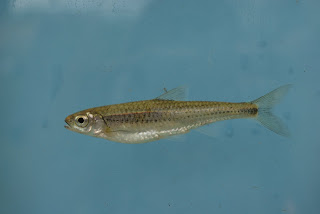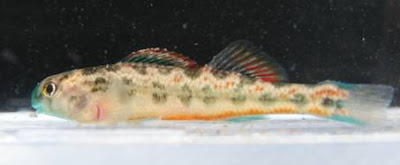
Telescope Shiner
Notropis telescopes
· Dark stitched lateral line
· Big eye
· Large belly

Rosefin Shiner
Lythrurus ardens
· dark triangular spot at dorsal fin origin

Crescent Shiner
Luxilus cerasinus
· Dark crescents
· Tall scales

Longnose Dace
Rhinichthys cartaractae
· Snout extends far in front of mouth
· Deep caudal peduncle

Mottled Sculpin
Cottus bairdi
· Color only a little lighter than bands
· Orange marking on dorsum

Stoneroller
Campostoma anomalum
· Large tubercles on head
· Horseshoe shaped mouth

Rosyside Dace
Clinostomus funduloides
· Mismatched scales
· Red markings
Blacknose dace
Rhinichthys atratulus
· Black stripe continues to snout

Fantail darter
Etheostoma flabellare
· Caudal fin “fan” shaped
Notropis telescopes
· Dark stitched lateral line
· Big eye
· Large belly

Rosefin Shiner
Lythrurus ardens
· dark triangular spot at dorsal fin origin

Crescent Shiner
Luxilus cerasinus
· Dark crescents
· Tall scales

Longnose Dace
Rhinichthys cartaractae
· Snout extends far in front of mouth
· Deep caudal peduncle

Mottled Sculpin
Cottus bairdi
· Color only a little lighter than bands
· Orange marking on dorsum

Stoneroller
Campostoma anomalum
· Large tubercles on head
· Horseshoe shaped mouth

Rosyside Dace
Clinostomus funduloides
· Mismatched scales
· Red markings
Blacknose dace
Rhinichthys atratulus
· Black stripe continues to snout

Fantail darter
Etheostoma flabellare
· Caudal fin “fan” shaped






































